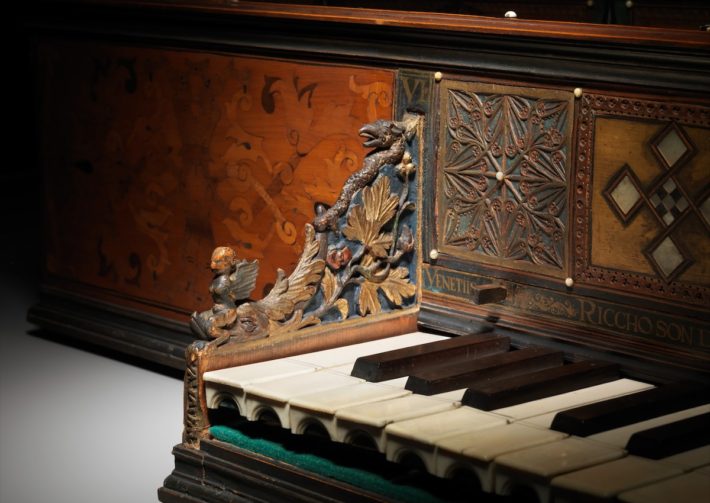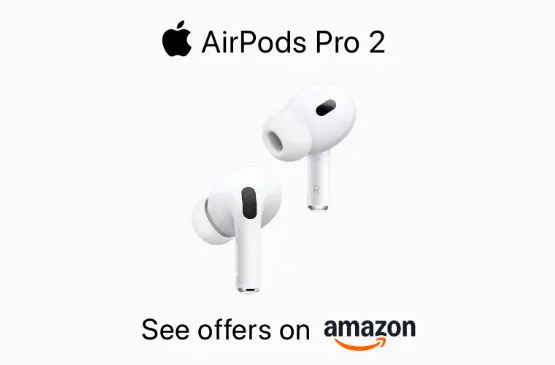Updated with new recordings: January 2, 2025. Originally published: September 2018.
This is Part 2 of our ‘Best Of‘ series about the best recordings of Bach’s Goldberg Variations. This part will recommend versions played on the Harpsichord, and the third part will recommend versions played on the piano. Read the first part here.
Part 2 – Bach – Goldberg Variations – Best Recordings on the Harpsichord
As mentioned in the first part of this guide, Wanda Landowska was the first to record the complete Goldberg Variations on a harpsichord. She played on a massive Pleyel instrument built specifically for her, designed to mimic the mechanics of a harpsichord while possessing the power to project in larger halls. The first Landowska recording, available from Warner Classics (now the owner of the old HMV/EMI catalog), was followed by a second version for RCA in 1945.
These recordings serve as an interesting historical document, though they feel somewhat out of place in the context of later 20th- and 21st-century interpretations. Landowska doubles the bass, adds embellishments in the repeats, and often sounds bombastic. That said, there are some charming moments, such as the fluid tempo and style in Variation No. 25, which she herself called “The Black Pearl.”
Later, specialists in the “authentic movement,” such as Ralph Kirkpatrick and Gustav Leonhardt, performed the work on more historically appropriate instruments, though these recordings emerged roughly 20 years after Landowska’s pioneering efforts.
Between the two, Leonhardt provides a more compelling interpretation. While Kirkpatrick occasionally sounds preoccupied with precision, Leonhardt seems more attuned to the emotional aspects of the Goldbergs. Kirkpatrick also struggles to escape the heavy sound of the double keyboard harpsichord. Leonhardt recorded the Goldberg Variations multiple times, but his first effort (1953) remains the most vital. Later recordings, though still of high quality, lack some of the freshness of his debut.
Karl Richter, another major Bach interpreter of the 1950s, approaches the work with the sensibilities of an organist (which he was), resulting in a performance that is best suited for devoted fans of his style. A similar observation applies to Helmut Walcha, another distinguished organist who took on the harpsichord with comparable results.
The first harpsichordist to emphasize the playful elements of the variations was Igor Kipnis. His 1976 recording remains a delight, full of vitality and inventive ornamentation. At times, his embellishments can be a bit much, but they certainly keep the listener engaged, adding suspense to each repeat. The recording itself is close and harsh, but as with many fine performances, this becomes secondary to the sheer enjoyment of the playing. Kipnis, however, lacks a unified vision for the work as a whole, seemingly more absorbed in the details of each variation. Unfortunately, his excellent recording is currently available only via streaming services, as the physical disc is no longer in production. If you have access to a streaming platform, it is well worth seeking out.
1980s Fever
As the 1980s arrived, the so-called “authentic movement” flourished alongside advancements in digital recording and the rise of CDs as the dominant format. This led to a surge of harpsichord recordings featuring prominent names in historically informed performance.
Trevor Pinnock was one of the leading figures of this movement. His performance is well-tempered but ultimately somewhat uninspired in ornamentation and phrasing. The dry sound of both the instrument and the recording space does little to elevate the experience. A similar issue plagues Kenneth Gilbert‘s recording. While his tempo choices are well-judged, his phrasing tends to emphasize the bar lines excessively, disrupting the natural flow of the music. The instrument he chooses is thin-sounding, and the acoustics further limit its impact.
On the other end of the spectrum, some performances introduce excessive excitement. Ton Koopman takes a highly ornamented approach, with manic trills and appoggiaturas that distract rather than enhance. His selective approach to repeats also raises questions.
Keith Jarrett, known for his extraordinary improvisational skills as a jazz pianist, treats the piece as a personal experiment on the harpsichord. His playing is rigid and often stiff, lacking the natural flow expected of an experienced harpsichordist. While one might anticipate intriguing embellishments or improvisational flourishes, the ornaments that do appear feel overly calculated and awkward. Jarrett’s other Bach recordings, particularly on piano, demonstrate a much more persuasive approach.
Things take a more engaging turn with Bob van Asperen, who performs on a surviving copy of a Mietke harpsichord—an instrument builder Bach himself reportedly commissioned. Van Asperen’s interpretation is fluid, tastefully ornamented, and never showy, maintaining energy and interest throughout. Discovering this recording was a pleasant surprise, and the additional works included in this two-CD set provide further enjoyment.
Settling into the 90s
As the 1990s arrived, the early preoccupation with strict authenticity began to wane, replaced by a generation of harpsichordists who felt more at ease with the instrument. Many of these artists studied under veteran specialists but developed a more natural and unforced approach to the Goldbergs.
Maggie Cole delivers a confident, rhythmically assured performance, with expert phrasing that conveys both long and short musical sentences. However, the recording quality is problematic—too close and seemingly artificially enhanced in the bass. This results in an overly tense and heavy sound when the two keyboards are used simultaneously, counteracting the fluidity of her interpretation. Variation 9, for example, exemplifies this tension. Still, it remains a strong interpretation.
Then came Pierre Hantaï, with a fresh, charming, emotionally charged, and technically superb recording (1993). One only has to listen to Hantaï’s performance of the Aria to be drawn into Bach’s world. The instrument, made by Bruce Kennedy in 1985 after a copy of an early 18th-century harpsichord, is recorded beautifully, with a natural and well-balanced acoustic. Each variation is meticulously shaped yet never sounds mechanical or overly calculated.
Hantaï revisited the Goldbergs in a later recording for the Mirare label (2003), where the same extraordinary level of execution remains. However, I personally prefer the earlier, more spontaneous-sounding recording for the Opus 111 label. This first version won the Gramophone Award that year and remains one of the finest.
Another impressive version stood somewhat in the shadow of Hantaï’s achievement: Blandine Verlet offers a freer, more flowing interpretation, though some listeners might find her occasional rubato and tempo fluctuations distracting. There is plenty of poetry and interest in this release, alongside some eccentricities—such as the overly fast tempo of the Aria and certain variations (the so-called “Black Pearl” variation, for example, feels almost comically rushed). Still, it remains an intriguing and highly enjoyable version.
Masaaki Suzuki starts well with the Aria, but then continues with a rather hectic performance of the first few variations. Like his monumental Cantata cycle, his playing here is immaculate, carefully planned down to the last note and ornament. However, it lacks a sense of wonder and spontaneity.
Another strong Goldberg version on the harpsichord comes from Céline Frisch (Alpha), whose solid, energetic, and fast-paced performance is immediately engaging. What I found less appealing were some detached phrasings, noticeable editing between variations, and a recording that can be harsh on the ear. It’s an enjoyable, easy-going interpretation—perhaps with a touch of superficiality. I certainly wouldn’t call it a “benchmark recording,” as Gramophone magazine did in its Goldberg Variations comparison a few years ago, but it remains a fine version nonetheless.
The same mix of strengths and quirks is also present in Ketil Haugsand’s version, though in his case, the recording engineering does a fine job of capturing the instrument’s sound. His tempo choices are occasionally unusual, disrupting the continuity of the cycle and giving each variation its own distinct pacing and character. While this approach may not suit all listeners, it offers an interesting perspective on the work. It’s a version worth considering as a second or third choice.
Big Names, Some Treasures
When Richard Egarr took over the Academy of Ancient Music from the late Christopher Hogwood, he recorded most (if not all) of Bach’s major ensemble and choral works, including one of the best versions of the Orchestral Suites and the Brandenburg Concertos. Moving away from the rushed, often hectic performances of the 1980s and 1990s, Egarr offers a more natural, expressive approach, where musical ideas unfold clearly and logically. His Goldberg Variations follows the same approach—never rushed, always thoughtful, and filled with nuance.
Every variation is fully explored, with ornaments adding subtle variety and revealing hidden voices. Variations 20 and 21, for example, showcase his ability to distinguish contrasting moods while maintaining a seamless flow. This is a Goldberg Variations performance for the ages—one that rewards repeated listenings.
Andreas Staier presents a compelling version for Harmonia Mundi, but his approach, while technically superb, can feel a bit rigid. His left hand is often too dominant, making some passages sound heavy-handed. That said, the instrument he plays offers interesting tonal possibilities, such as a lute stop effect in Variation 19 and a more delicate sound in Variation 15. This makes it an enjoyable listen, especially for those following along with a score.
I was less enthusiastic about Mahan Esfahani’s version for Deutsche Grammophon (2016). His “back to basics” Aria, reminiscent of Wilhelm Kempff’s approach, is intriguing, but the overall interpretation is somewhat clinical, with odd tempo and phrasing choices. The dry recording also detracts from the warmth of the performance.
Pieter-Jan Belder takes a solemn approach to the Aria, reserving his energy for the variations. He alternates between keyboards for the repeats, adding intriguing ornamentation that, while not the most inventive, keeps the performance fresh and engaging. His tempo remains steady, though his tendency to slow down at the end of phrases can become predictable after a while. The “Black Pearl” variation comes across as slightly restless, perhaps overly edgy, but the well-chosen instrument and high-quality recording add to the appeal.
Diego Ares begins with an unusual improvisation that feels too grand in scale compared to the Aria and is best skipped. His flowing tempi push forward when he wants to inject emotional charge, often incorporating rubato more prominently than most, though within a convincing interpretative framework. The resonant acoustics complement his generous ornamentation, though his use of octave shifts—such as in Variation 9—can sometimes sound unusual.
Anne-Catherine Bucher sets an optimistic tone with a bright and sunny interpretation of the Aria, an approach that carries through the entire performance. She conveys a sense of joy and appreciation for the work without imposing excessive interpretative interventions. The recording is clear and clean, and while the instrument itself lacks brilliance, it fits the overall character of her reading.
Marcin Świątkiewicz brings a certain gravitas to the opening of his performance, somewhat reminiscent of Richard Egarr, though with less restraint. However, he employs a device that doubles the bass, similar to Wanda Landowska’s old recordings, which makes the harpsichord sound almost overwhelming—unfortunately, not in a way that serves the music. While some variations are excellently played, the bizarre approach to a few prevents this from being a top recommendation.
Michel Kiener enjoyed success with his release of the complete Rameau harpsichord works and also recorded The Well-Tempered Clavier successfully, but his Goldberg Variations do not quite reach the level of these other albums and sometimes sound heavy-handed. He is also not well served by a dry recording.
Jean Rondeau presents one of the more reflective versions, allowing extra breathing time between sections and variations. Somehow, this doesn’t seem overdone or tedious, even though, at 107 minutes, this is one of the longest versions. If you give this performance the patience it requires, it is a very rewarding listen. Rondeau’s ability to create a singing quality with the excellent harpsichord he uses is remarkable, and the recording is good, though it tends to be on the resonant side.
The “Sleeper” Version
I was just about to close the book on my recommendations for the best Goldberg Variations recordings when I came across the “sleeper” version I mentioned in Part 1—a recording that, if not entirely ignored, had certainly not had its time in the spotlight. With no major label or well-known performer backing it, this version had largely flown under the radar.
Ignacio Prego is a Spanish harpsichordist, and his version of the Goldbergs on the Glossa label (2016) is a joy from start to finish. He is perhaps to our day what Pierre Hantaï was to listeners in the 1990s. His performance offers endless beauty, depth, and skill, along with many small surprises in the repeats—try the first variation as a whole, for example, and see if you can resist listening to more. He also benefits from a clear, easy-on-the-ear recording on a wonderful instrument. This release was a wonderful surprise and deserves recognition among the best.
The Choices
To conclude this long (but satisfying) comparison of harpsichord recordings and select my top three versions of Bach’s Goldberg Variations on the instrument, I arrive at three standout interpretations.
I feel that Richard Egarr plays as if his life experience is woven into his interpretation, without losing any of the freshness and sense of wonder this major work inspires. As I mentioned earlier, he takes his time compared to other versions (or perhaps they are the ones who rush?), but when you finish listening, you are left with a sense of inevitability that few other interpretations achieve.
Pierre Hantaï’s first take on the Goldberg Variations remains as exciting and moving as it was upon its release and should be heard by any Bach or Goldberg Variations enthusiast. Though somewhat difficult to find on CD, it is available on streaming services. His second version, recorded for the Mirare label, is still readily available.
And for the “Sleeper” version, Ignacio Prego delivers a performance bursting with talent that is hard to resist, even for veteran Goldberg Variations listeners such as this writer.
These three versions blend the best of what the Goldberg Variations can offer on the harpsichord and serve as a gateway for listeners to explore both older and newer recordings, some of which have been mentioned above.
Goldberg Variations – The Best harpsichord Versions
Richard Egarr:
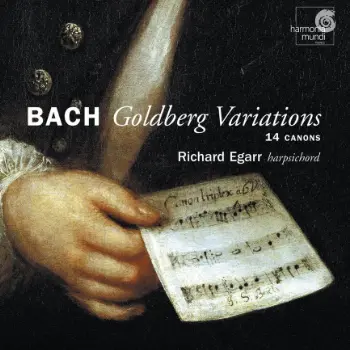
Pierre Hantaï:
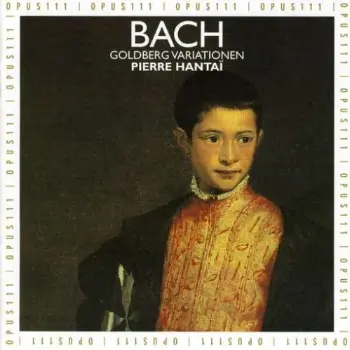
Ignacio Prego:
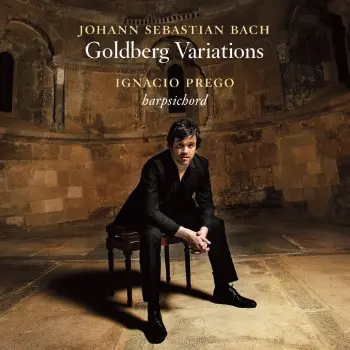
This is the end of part 2 of the “best of” series about Bach’s Goldberg Variations. The next and final part, to be published in the next few weeks, will offer another 3 recommended recordings on the piano.
Sign up for our newsletter to stay updated with new guides and classical music album reviews.

